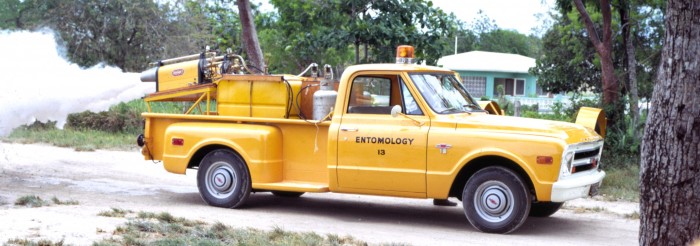
The MRCU mission is
“To suppress mosquito populations so as to minimise discomfort from mosquito biting. To protect residents and visitors from mosquito-borne disease, and thereby enhance the quality of life and promote the economy of the Cayman Islands.”
The Mosquito Research & Control Unit (MRCU) was established in 1965 when Marco Giglioli arrived from London with instructions ‘to establish a laboratory and conduct research with a view to advising the Cayman Government on suitable methods of control.’
The Mosquito Research and Control Unit aims to help Cayman Islands residents by reducing mosquito nuisance and protecting against mosquito-borne diseases such as malaria and dengue which are common in the region.
To do this, we employ an Integrated Pest Management approach, using a range of physical, biological and chemical control techniques to minimize nuisance levels of mosquitoes and prevent disease transmission.
History of MRCU
- 1834 – The first record of a mosquito problem on Grand Cayman by the Governor of Jamaica who when visiting noted ‘The mosquitoes there amount to quite a national misfortune.’
- 1938 – The first known survey of species was carried out by a visiting sanitary inspector followed the same year by a team from Oxford University
- 1948 – Further surveys carried out by a visiting malariologist (Dr G Giglioli)
- 1965 – The Mosquito Research & Control Unit was established under the control of Dr Marco Giglioli to prevent vector borne disease and to reduce nuisance biting. A laboratory was set up on the current site of George Town hospital A&E.
- 1966 – The Mosquito (Research &) Control Law was first passed.
- 1966 – The first vehicle mounted fogging unit (a Tifa Todd machine) hit the streets of George Town by 1969 there were 9 fogging units mostly mounted on Mini Mokes, staffed largely by volunteers.
- 1967 – Dyke building began in the swamps of Grand Cayman and the network of dykes and canals grew until 1983. This allowed for the swamp levels to be manipulated to interrupt the breeding cycles of the swamp mosquito.
- 1968 – Port disinsection began; arrangements were made for the spraying of any ship or aircraft arriving in Grand Cayman.
- 1970 – Operations began in the Sister Islands.
- 1971 – The first aerial insecticide campaign took place using malathion from a Cessna Ag-Wagon aircraft.
- 1971 – Dr Giglioli the Director of MRCU was awarded the Order of the British Empire (O.B.E) medal for his work in mosquito control.
 1972 – Aerial applications began on a large scale.
1972 – Aerial applications began on a large scale.- 1974 – Records were broken when 793,103 mosquitoes were caught in a trap in Bodden Town in a single night.
- 1987 – Due to the appearance of insecticide resistance to conventional insecticides, hormonal and bacterial insecticides are introduced.
- 1996 – Moved to the Giglioli Building on North Sound Road.
- 1996 – Further excavation of the swamps (the creation of ‘canalitos’) increasing the flow of water in and out of the swamp with tide and rainfall.
- 2003 – Large scale larviciding operations (using temephos) were first carried out and larvicing remains the mainstay for control of the swamp mosquitoes.
- 2006 – the MRCU moves to it’s current custom built building on Red Gate Road.



